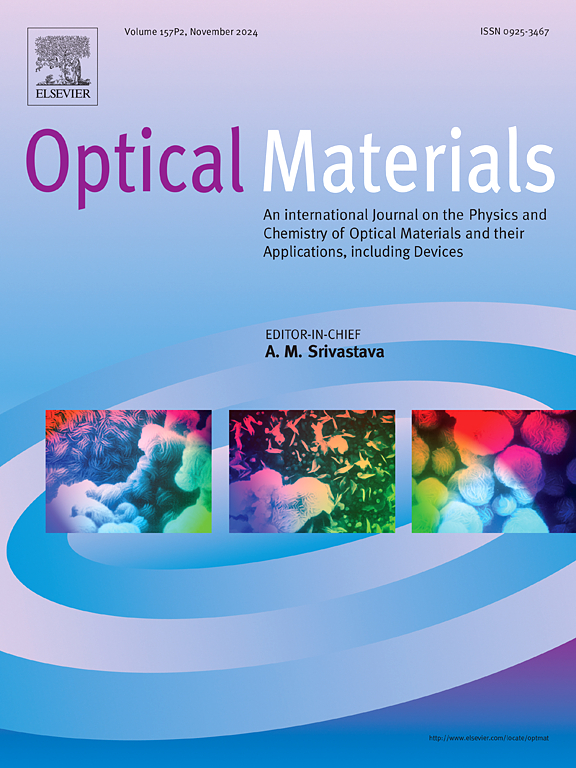锂离子掺杂增强CaLaGaO4:Eu3+红发荧光粉的光致发光性能
IF 3.8
3区 材料科学
Q2 MATERIALS SCIENCE, MULTIDISCIPLINARY
引用次数: 0
摘要
通过高温固相反应合成了CaLaGaO4:Eu3+和Li +掺杂CaLaGaO4: 30% Eu3+系列荧光粉。结果表明,这些荧光粉可以在392 nm的近紫外光下有效激发,并在609 nm处发出强红光。609 nm处的红色发射对应于Eu3+ (5D0→7F2)的超敏电偶极跃迁。当Eu3+掺杂浓度达到30%时,出现明显的浓度猝灭现象。随后的Li+共掺杂研究表明,加入0.5% Li+可显著增强发光强度:(1)室温荧光强度比未掺杂Li+的荧光强度增强1.56倍;(2)绝对量子产率(QY)由11.3%提高到21.6%,相对提高91.2%;(3)热稳定性表征表明,在498 K时强度保持率为81.9%(未掺杂体系为75.0%),热耐力相对提高了9.2%。这些结果表明,Li+的引入可以有效地敏化和增强宿主基质的荧光特性,为提高荧光材料的性能提供了一种有前途的策略。本文章由计算机程序翻译,如有差异,请以英文原文为准。
Enhanced photoluminescence of a novel red-emitting phosphor of CaLaGaO4:Eu3+ by lithium ion doping
CaLaGaO4:Eu3+ and Li + -doped CaLaGaO4:30 %Eu3+ series phosphors were synthesized via high-temperature solid-state reactions. The results show that these phosphors can be efficiently excited by near-ultraviolet light at 392 nm and emit intense red light at 609 nm. The red emission at 609 nm corresponds to the hypersensitive electric dipole transition of Eu3+ (5D0 → 7F2). Upon reaching 30 % Eu3+ doping concentration, a distinct concentration quenching phenomenon emerges. Subsequent Li+ co-doping investigation demonstrates that incorporating 0.5 % Li+ induces remarkable luminescence enhancement: (1) The room-temperature fluorescence intensity exhibits 1.56-fold augmentation compared to Li+-free counterparts; (2) The absolute quantum yield (QY) increases from 11.3 % to 21.6 %, representing 91.2 % relative improvement; (3) Thermal stability characterization reveals 81.9 % intensity retention at 498 K (vs. 75.0 % in undoped system), corresponding to 9.2 % relative enhancement in thermal endurance. These findings suggest that the introduction of Li+ can effectively sensitize and enhance the fluorescence properties of the host matrix, offering a promising strategy for improving the performance of fluorescent materials.
求助全文
通过发布文献求助,成功后即可免费获取论文全文。
去求助
来源期刊

Optical Materials
工程技术-材料科学:综合
CiteScore
6.60
自引率
12.80%
发文量
1265
审稿时长
38 days
期刊介绍:
Optical Materials has an open access mirror journal Optical Materials: X, sharing the same aims and scope, editorial team, submission system and rigorous peer review.
The purpose of Optical Materials is to provide a means of communication and technology transfer between researchers who are interested in materials for potential device applications. The journal publishes original papers and review articles on the design, synthesis, characterisation and applications of optical materials.
OPTICAL MATERIALS focuses on:
• Optical Properties of Material Systems;
• The Materials Aspects of Optical Phenomena;
• The Materials Aspects of Devices and Applications.
Authors can submit separate research elements describing their data to Data in Brief and methods to Methods X.
 求助内容:
求助内容: 应助结果提醒方式:
应助结果提醒方式:


